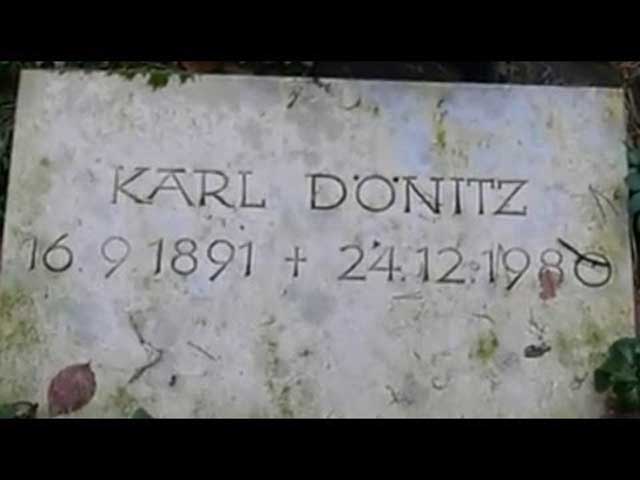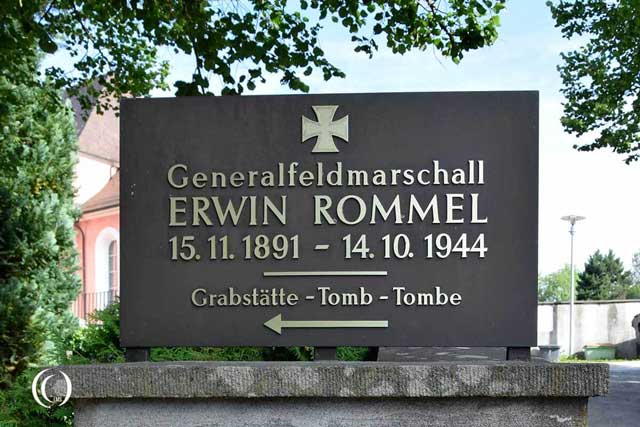What Happened to the Leaders of the Third Reich?
The leaders of the Third Reich met a variety of fates. Some were assassinated, others committed suicide, many went to prison, and a surprisingly large fraction escaped virtually any real consequences and lived out their normal life spans. Millions of Germans lost their lives in World War II, and there were hundreds if not thousands of recognizable names from the twelve-year history of the Third Reich. So, no article like this can be comprehensive. The intent is to summarize in succinct fashion the
final resting places of the leaders of the Third Reich to the extent that they are known.
The Fate of Third Reich Political Leaders
 |
| Defendants in the dock at the first Nuremberg trial. Front row from left to right: Hermann Göring, Rudolf Hess, Joachim von Ribbentrop, Wilhelm Keitel, Ernst Kaltenbrunner, Alfred Rosenberg, Hans Frank, Wilhelm Frick, Julius Streicher, Walther Funk, Hjalmar Schacht. Second row from left to right: Karl Dönitz, Erich Raeder, Baldur von Schirach, Fritz Sauckel, Alfred Jodl, Franz von Papen, Arthur Seyss-Inquart, Albert Speer, Konstantin von Neurath, Hans Fritzsche. |
The top German government officials and military officers of World War II were hanged and their bodies were cremated. The sentences were carried out in the gymnasium of Nuremberg Prison by the United States Army. The men executed were:
- Hans Frank
- Wilhelm Frick
- Alfred Jodl
- Ernst Kaltenbrunner
- Wilhelm Keitel
- Joachim von Ribbentrop
- Alfred Rosenberg
- Fritz Sauckel
- Arthur Seyss-Inquart
- Julius Streicher
The court sentenced Hitler's top aide,
Martin Bormann, to death
in absentia. However, Bormann escaped from the Fuehrer bunker at the end of the war. There is speculation that Bormann perished from artillery fire during this escape. A skull unearthed in Berlin along his projected escape route was tested for DNA in 1998 and found to be a close match with Bormann's son, so he is presumed to have died within minutes or hours of his exit from the bunker.
 |
| Martin Bormann's end apparently came in Berlin near those white sheds on the right, at the now-abandoned Invalidienstrasse bridge which crossed some railroad tracks. |
Joachim Ribbentrop, Wilhelm Keitel, and the others hanged at Nuremberg were cremated at Ostfriedhof, Munich, and their ashes were scattered in the Isar River (specifically, they were thrown into the Wenzbach/Conwentzbach, a small stream in Munich).
 |
| The final photo of Hermann Goering. |
Hermann Goering, who
committed suicide right before his scheduled hanging, also had his remains cremated and his ashes scattered. Some sources state that Goering’s ashes were scattered (poetically) at Dachau or Auschwitz, but they were almost certainly scattered at the same place as the remains of Ribbentrop and the others.
 |
| The site of the Fuhrer Bunker in Berlin, where Joseph Goebbels' remains were found. The site is now a parking lot and apartment complex. |
Joseph Goebbels committed suicide in the Berlin bunker with Hitler and his body was burned there (though not completely). After that, the trail becomes tenuous. Goebbels’ corpse was taken to an unknown location in the Soviet Union where the cremation was completed. According to the Soviets, the ashes were scattered at an undisclosed location. There is very little proof of this, though there are some very clear pictures of Goebbels’ charred corpse in Berlin.
 |
| Gravestone of Karl Dönitz (Doenitz). |
Karl Dönitz, last Fuehrer of Greater Germany, last Großadmiral to date of Germany, and longtime U-boat fleet commander, spent ten years in captivity. After his release on 1 October 1956, Dönitz retired to Aumühle and wrote two autobiographical books. Dönitz passed away there from a heart attack on 24 December 1980 at the age of 89. He is buried in Waldfriedhof Cemetery in Aumühle.
 |
| One of the last photographs of Heinrich Himmler. |
Heinrich Himmler took cyanide after the British captured him in northern Germany shortly after the end of the war (he was in disguise and trying to escape to parts unknown). Himmler’s remains were buried in an undisclosed location in northern Germany, supposedly in a forest. The British soldiers who buried Himmler did not tell anybody the location, including, apparently, their superiors. Their reason for keeping this secret was to prevent the creation of a fascist shrine. The spot, if anyone still knows where it is, remains a secret.
 |
| Albert Speer's gravesite. |
Albert Speer spent 20 years in Spandau military prison and was released in 1966. Afterward, he embarked on a sustained campaign to rehabilitate his image which was at least partially successful. He died of a suspected cerebral hemorrhage/stroke in London in 1981 and is buried in Heidelberg. The bodies of others who were imprisoned and ultimately released were treated individually.
 |
| The temporary grave of Rudolf Hess in Bavaria. |
Rudolf Hess spent the better part of five decades in various prisons beginning in 1941 after his
10 May 1941 flight to Scotland. Hess committed suicide at the age of 93 in Spandau Prison in August 1987. Hess initially was buried at a secret location to avoid media attention or demonstrations by fascist sympathizers. However, his body quietly was reinterred in a family plot at Wunsiedel on 17 March 1988. However, because the Hess gravesite became a favored pilgrimage for his fans, his family, the town, and the church had his body exhumed and cremated and the
gravesite eliminated in 2011. According to news reports, Rudolf Hess' ashes were scattered at sea.
The Fate of Third Reich Generals
German generals usually were buried in military cemeteries and remain there, though some have been dug up and reinterred in new locations for various reasons. The locations vary widely, and a lot depended upon how long after (or before) the end of the war the officer died and where his family (or body) was located. Some locations are not known, including that of
Field Marshal Paul Ludwig “Ewald” von Kleist, who was starved to death in captivity at Vladimir Prison Camp in the Soviet Union and buried there.
 |
| Heinz Guderian’s grave in Goslar. |
Most of the graves of German generals are known, however.
Heinz Guderian, for instance, is buried at the Friedhof Hildesheimer Straße in Goslar (“Friedhof” is just German for graveyard or cemetery).
 |
| Erwin Rommel gravesite. |
Erwin Rommel is buried in Herrlingen, Blaustein, Baden Württemberg, Germany. The longer after the war the death occurred, the more say the family had in what to do with his or her remains.
 |
| The gravestone of Hans-Valentin Hube. |
The graves of Rommel and Guderian are quite grandiose. A somewhat more typical grave of a German general is that of
Generaloberst Hans-Valentin Hube, who perished in a plane crash in April 1944. Hube was extremely popular in the Third Reich during World War II but is largely forgotten today. Hans-Valentin Hube is buried at the Invalidenfriedhof, Berlin-Mitte, Mitte, Berlin, Germany.
The Fate of Female Third Reich Leaders
 |
| Gravestone of Hanna Reitsch. |
Incidentally, there were some top female members of the Third Reich, though they tended to serve in an unofficial capacity.
Hanna Reitsch, for instance, was a famous test pilot, though not officially a member of the Luftwaffe (which helped to keep her out of prison after the war). Reitsch committed suicide in Frankfurt in 1979 and is buried in Austria, Salzburg, Kommunal Friedhof.
Leni Riefenstahl, the filmmaker who created the famous/notorious “Triumph of the Will” and “Olympiad,” lived to be 101. Like Speer, Riefenstahl somewhat rehabilitated her reputation and definitely outlived many of her critics. Riefenstahl died in her sleep on 8 September 2003 at her home in Pöcking, Germany, She is buried at Munich Waldfriedhof, Munich, Germany.
The Fate of Third Reich Ordinary Soldiers
 |
| The grave of Kurt Knispel. |
It is the nature of war that ordinary soldiers are buried or wound up at every battlefield, under every ocean, on every mountain range. Remains of German soldiers are being recovered to this day and reburied. Some of the Germans being found were very prominent in the Third Reich, though that does not necessarily mean they are well-known today. The usual burial spot now is a military cemetery in the country considered most appropriate, which is not necessarily Germany. This, for instance, was the case with top panzer ace
Kurt Knispel, whose body was found in 2013 in a mass grave in the village of Vrbovec, Czech Republic. The German War Graves Commission reburied Knispel, an ethnic German from Czechoslovakia, in 2014 in the Central Brno military cemetery in Brno, Czech Republic.
 |
| Joachim Peiper's tombstone. |
Joachim “Jochen” Peiper was a colonel (Standartenführer) in the Waffen-SS who served as a unique bridge between the troops and the Third Reich hierarchy. He alternated between field commands and serving at Heinrich Himmler's side as one of his adjutants. Peiper survived the war and also survived an Allied death sentence for war crimes when his sentence was commuted and he was released. After holding a variety of auto manufacturer jobs, Peiper retired to Traves, France in 1972. On the night of 13/14 July 1976, unknown assailants burned down Peiper's house with him in it. His charred corpse was found with a bullet hole in the head. Peiper was buried at Schöndorf am Ammersee Village Cemetery, Schondorf, Germany. He remains there as of this writing, but there is some sentiment to remove him just as the grave of Hess was removed.
The Fate of Adolf Hitler
 |
| The last known photo of Adolf Hitler, taken at the entrance to the Fuhrer Bunker in Berlin in 1945. |
As for
Adolf Hitler, well, nobody really knows his final resting place, though there are various claims of varying degrees of certainty. Hitler’s final location has been the subject of intense study and debate that continues to this day. Some obscure Soviet functionaries claimed to have cremated Hitler’s remains around 1970 and thrown the ashes into a river in East Germany. That is unconfirmed, though there is some corroborating evidence (such as the remains of a primitive crematorium at the location in question). This account appeared only decades after the war, which raises questions about its authenticity. Joseph Stalin, who presumably would have known any developments in the search for Hitler because it was an issue that obsessed him, reportedly believed that Hitler had escaped. Bone fragments purported to be of Hitler’s cranium are held in the Kremlin, but they have been tested and found to be those of a woman. So, the location of Hitler’s body or ashes is unknown.
 |
| Graves of German Fallschirmjaeger (paratroopers). |
2019














































